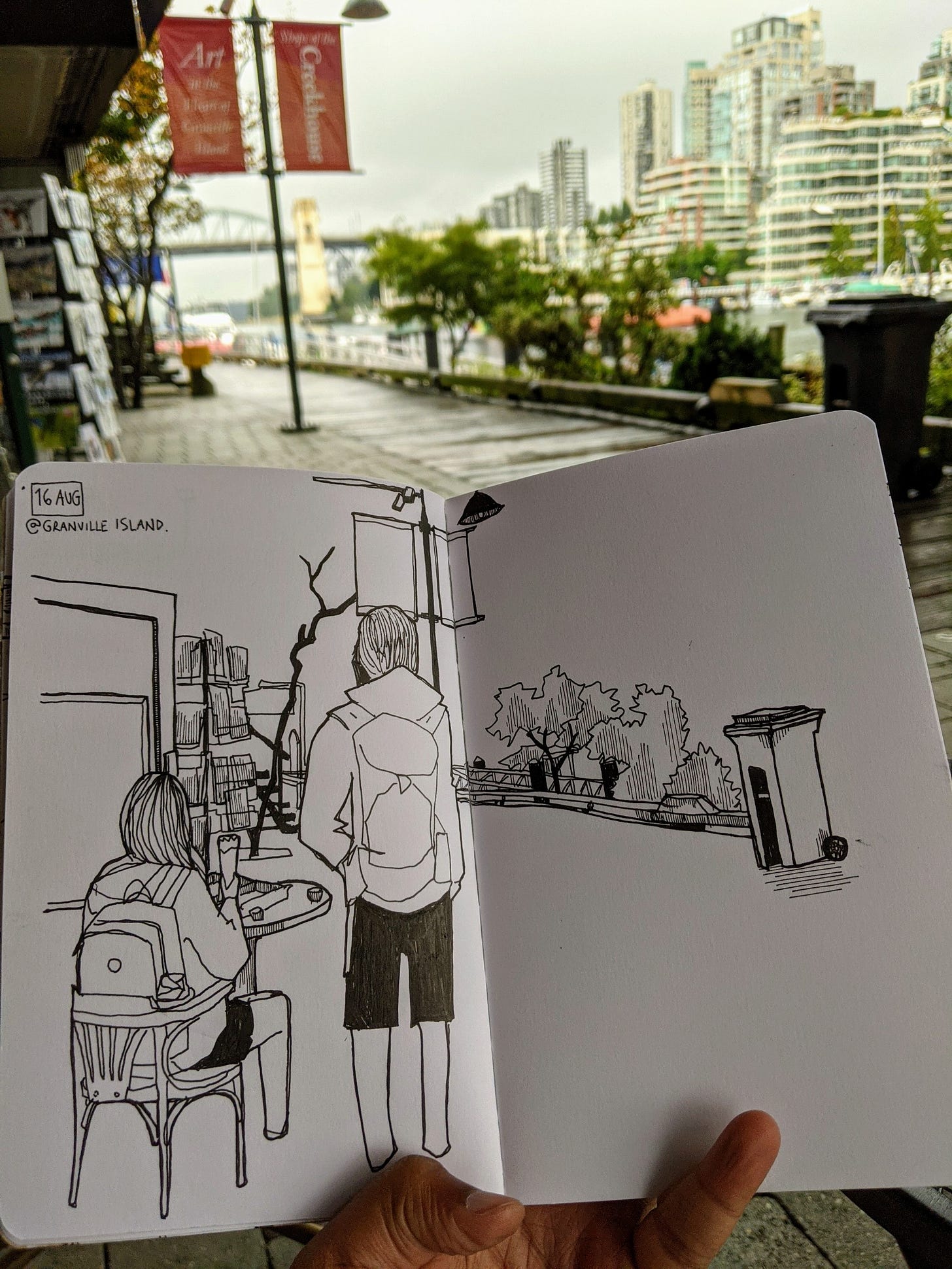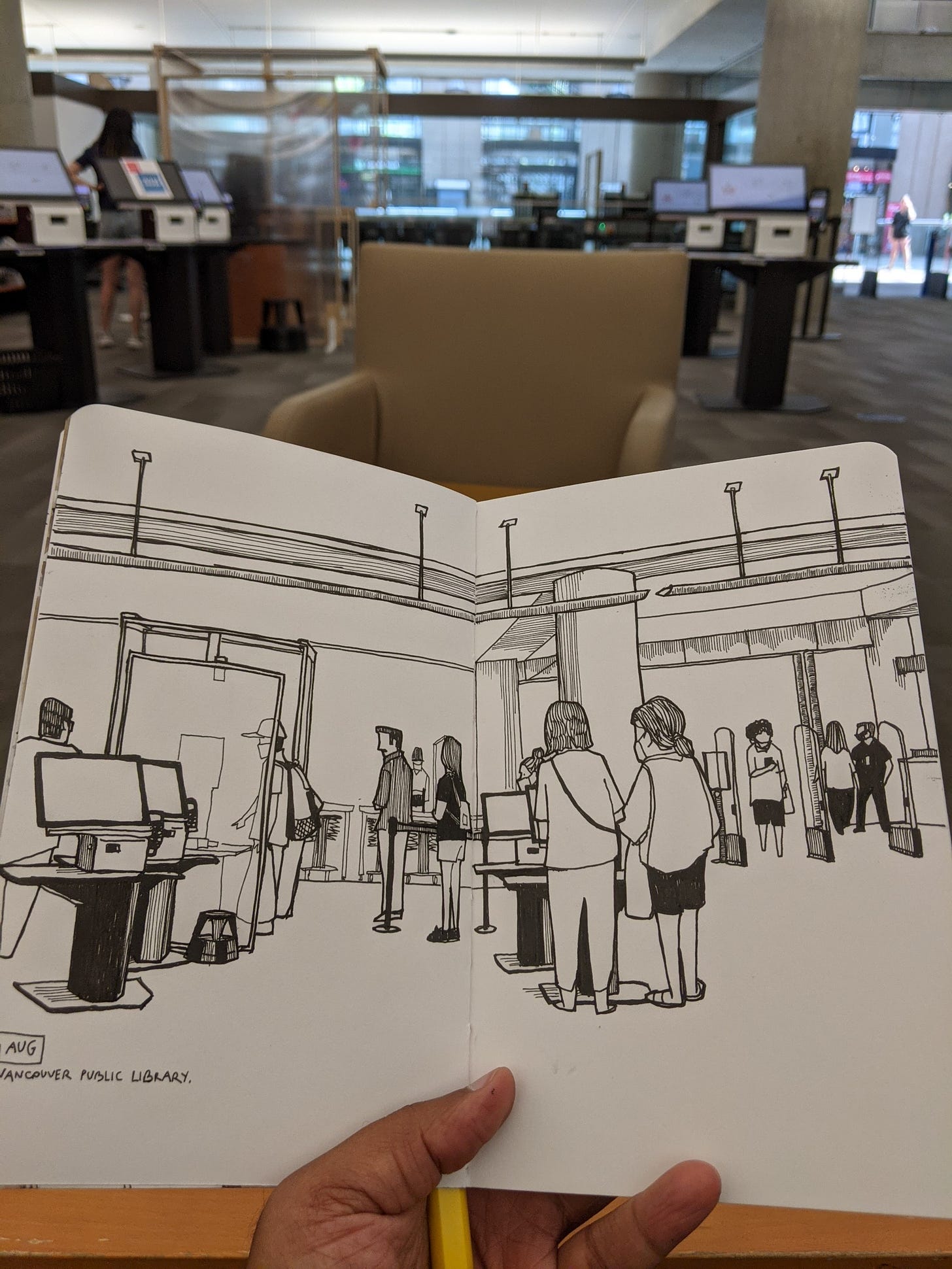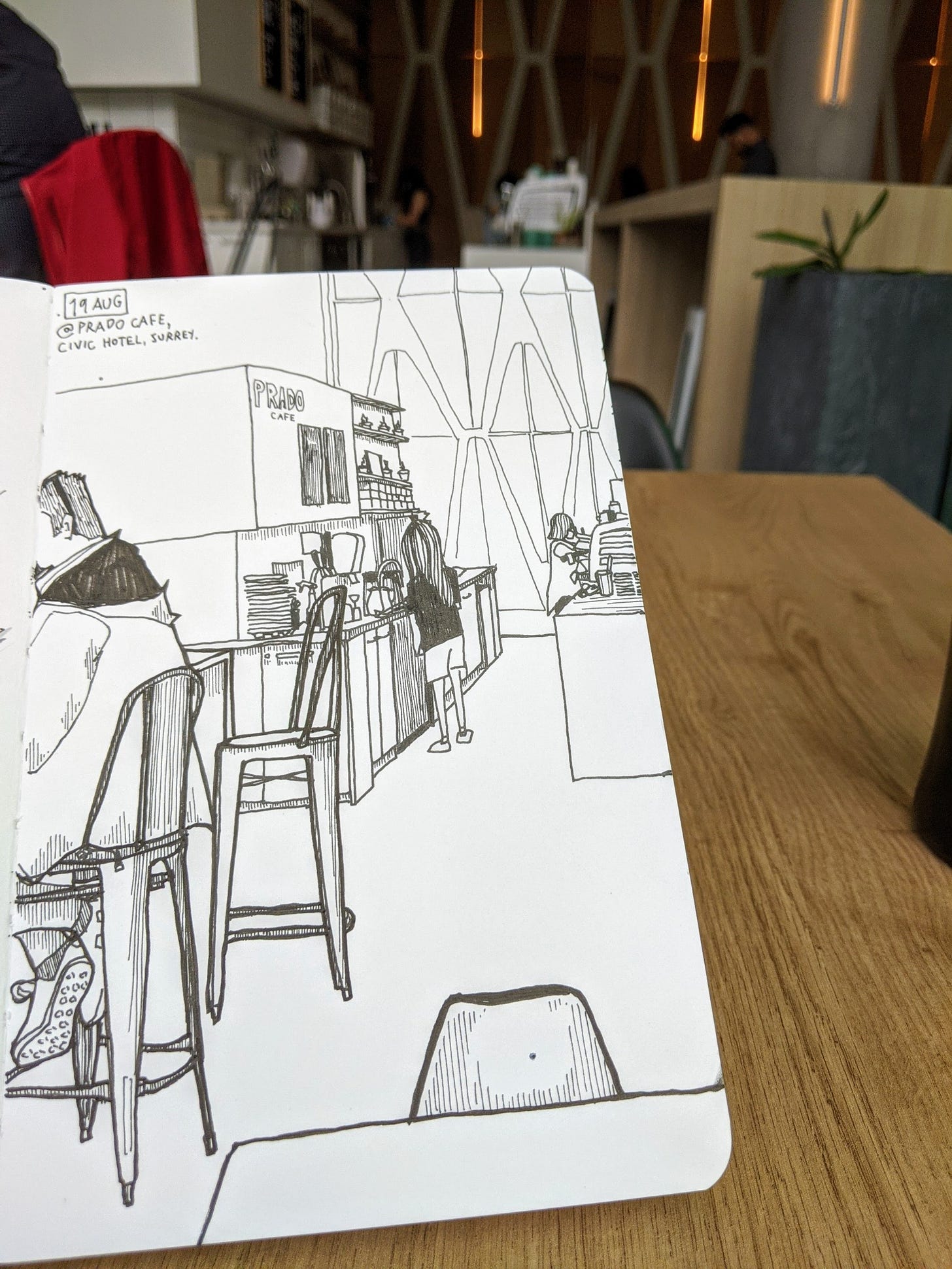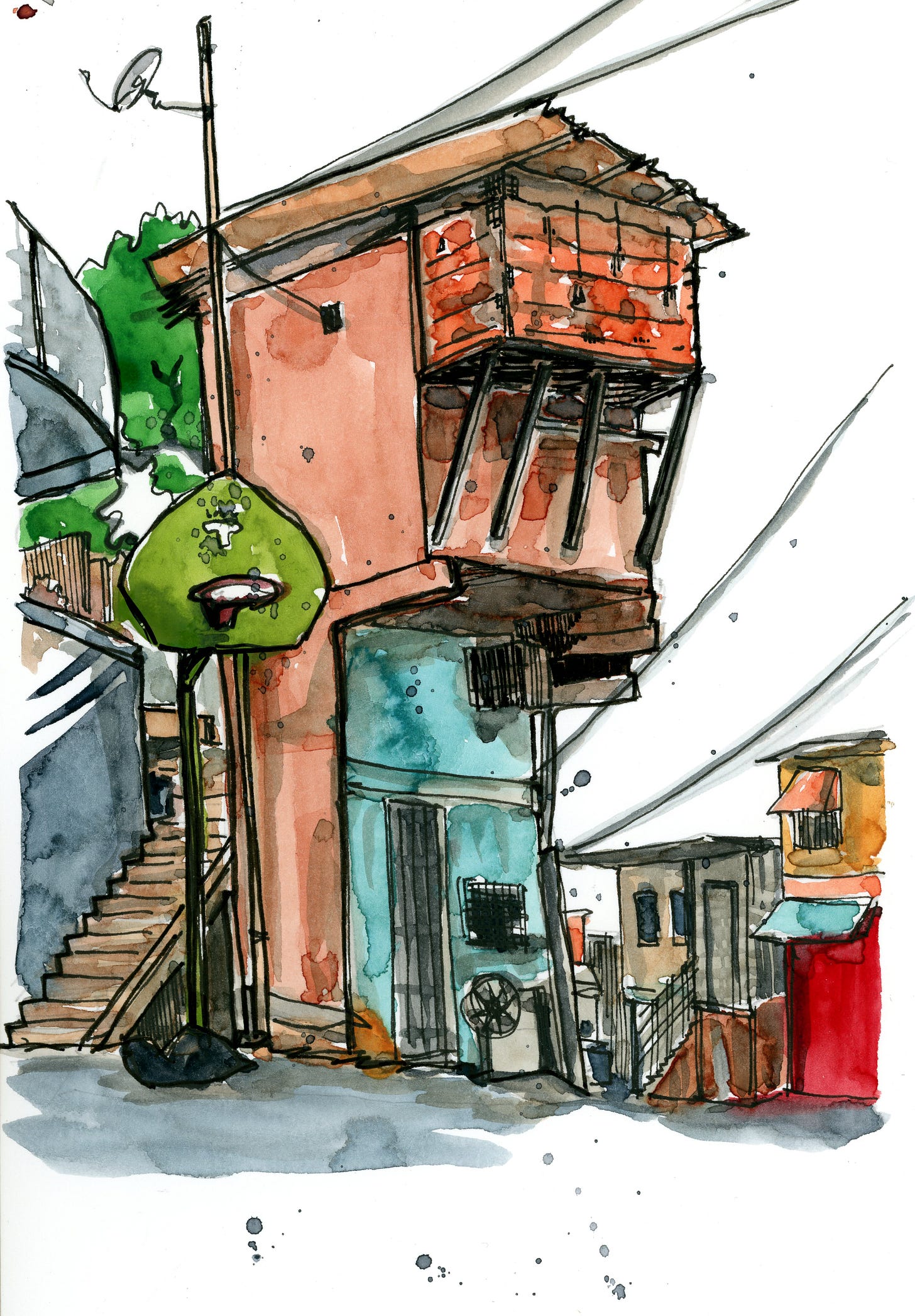59 - The Library of Good Lines
Hello and welcome to the SneakyArt Post. This is a newsletter about my art, the SneakyArt Podcast, and ideas from my journey of self-education as an artist.
This week, I want to share a thought I had from visiting the Vancouver Public Library, some recent commission work, and an interview I did with The Tyee.
Interview with The Tyee
I spoke with Dorothy Woodend and Christopher Cheung at The Tyee, about my work as a SneakyArtist and the story of how I came to be in Vancouver.
I usually do not read the interviews I give, but I was pleasantly surprised when scanning through this one. Chris and Dorothy have added value to my ideas with mention of the Urban Sketching movement and some other artists. Check it out!
…
I spoke with them at Granville Island on a rainy afternoon. After the interview, I walked about looking for a coffee and an empty seat. Dry places to sit are a premium once it begins to rain. But I found a spot under the canopy of a cafe just off the main dock, away from the touristing throng. From time to time, the wind sneaked raindrops in under the canopy and onto my page, and I would wipe them away.
The Library of Good Lines
I got a library card last week, which is a thing you can do for free. It lets me borrow 10 books at a time for up to 3 weeks. Can you believe that?
If libraries hadn’t already been invented, and someone tried to advocate for them today, they would be dismissed as impractical and anti-capitalist.
It might be the greatest boon left to us by previous generations.
I like the Vancouver Public Library very much. The exterior is designed like the Colosseum in Rome, and one of these days I will sit across the road from it and make a sketch. It is cosy, comfortable and air-conditioned. It is a downtown oasis where I can shelter from hot summer days. When the winds changed direction last week and engulfed the city with the smoke of distant wildfires, it became my refuge.
It has been a very long time since I spent my days wandering among unknown books.
I was confronted by thoughts that have not entered my mind in many years. It is well and good to shop online or borrow e-books on your iPad. But tech cannot give you the sense of wonder from walking through endless aisles of endless books. Because it’s not enough that we be able to immediately find exactly what we are looking for.
We need to feel lost in the knowledge of the world.
The practice of browsing through shelves of books, not knowing which one you want, is a good thing. You consider every title, and you wonder about the contents. You observe curled pages, and tattered covers, all signs of use, and think about those who have read them before. An oasis does not belong to you alone. You read authors' names and imagine what it must be like to write an entire book on one emperor who lived 2000 years ago. Was it that writer's entire field of study? Did they write other things?
You browse through sections of your interest, and eventually find some good things to read. Soon enough, you find a place to sit. Nobody will disturb you now. It is just you and the best words of other people.
…
This week, I spoke with a guest on my podcast who described his loose style of drawing as coming out of a database of lines, shapes, and curves, that he has built over decades of art practice.
“It is very difficult to look simple.”
With previous guests too I have discussed building a ‘vocabulary’ of shapes over time. I think of them as ear-shapes, nose-shapes, faces, body-shapes, lamp-posts, cars, and buildings, and trees. Every time I draw from observation, I translate my three-dimensional reality, using this vocabulary, to 2-dimensional form. If the shape I create is sufficiently new, it is catalogued for future use. Thus I add to the haphazard collection of things I can draw. I build my Library of Good Lines.
It is every artist’s indirect job to build their own library. Here we stash images we see, making notes about color or composition or style. Here we store ideas we borrow from others. Here we note the rules as we learn them and interesting ways to break them. And here we file all our experiments, the ones that succeed but also the ones that fail. Every good artist is both a librarian and a curator.
Reading in a library feels right. It is quiet, comfortable, and private. Anyone else you see is engaged similarly. But after some reading, and making notes for the podcast, I needed to stretch my mental muscles as well as my legs. So I took out my sketchbook and went up and down the floors, in search of a place with a view. I found it at the entrance foyer, on a comfortable sofa in front of the self-checkout machines.
Currently Reading…
I borrowed two books from the library. I have a trick for reading them both simultaneously. The trick is this - each book stays in a separate room, at hand whenever I want to read something.
My bedroom reading this week is Isaiah Berlin’s ‘The Power of Ideas’. My living room reading is Anthony Everitt’s ‘Hadrian’, about the great Roman emperor.
Pluralism
Isaiah Berlin was a thinker, philosopher, and professor of political theory at Oxford. He is popular for his inaugural lecture “Two Concepts of Liberty”, where he explains negative and positive liberty - as “freedom from” and “freedom to”. Negative liberty can be thought of as more individualistic, granting individuals freedom from institutional interference. Positive liberty is that which allows people freedom to attain clearly defined ends. Here, institutions are seen as protecting freedom and our ability to achieve our goals.
I heard about Isaiah Berlin in a two-part series in the podcast Philosophize This. Here, the podcaster talks about the political philosophy for which he is best known - Pluralism.
Pluralism can be simply defined as the philosophy which acknowledges that different people (and cultures) can come to different conclusions or truths about the world. It advocates the necessity to accommodate diverse ideas and mindsets within a political system.
It pushes against a rationalist idea of the world - that, like in the sciences, given enough information, we will all come to the same conclusions. It is easy to think this way about the world, but often we find it not to happen. This leads us to conclude that other people are either foolish (unable to see things as we do) or malicious (unwilling to see things as we do).
Pluralism requires us to extend empathy to other people, and urges good faith dialogue. I’m still in the early part of the book, and excited to learn more as I go deeper. If you are curious, I highly recommend the podcast link above.
Commission Work
I just completed a three-piece commission for a client in Wisconsin. It is a set of illustrations of their wedding photos, drawn to memorialize the special day. The couple live in Eau Claire, WI, and I know them from the book launch of SneakyArt of Eau Claire, when they came to buy a copy. Here’s a video of the final drawing. I’ll be putting them in the mail this week!
Other Art this Week…
Speaking of commissions, I went to Surrey City Hall to deliver the drawing I made at Surrey Plaza. Before leaving, I grabbed a coffee and an opportunity for SneakyArt at the nearby Prado Cafe.
This week, I also got back into watercolors. I joined the fantastic artist Alvin Chong to draw from a reference image live on IG.
It was a spur of the moment decision to do colors, and I feel a little rusty, but I have a plan to get back into it. More details about my ‘plan’ soon.
Links
Isaiah Berlin - [Wiki] [Philosophize This podcast] [Pluralism Wiki]
Interview with The Tyee
SneakyArt on Instagram
Info and a link to buy my book, SneakyArt of Eau Claire
That’s all from me this week. Next week, I will have a new episode of the SneakyArt Podcast, and some exciting ideas for a lot of new content! Thank you for your time and attention.






So much talent! I love it ALL!
Nishant!!!! You're supremely talented and this was such a delight to read, thank you! Lovely to meet you.